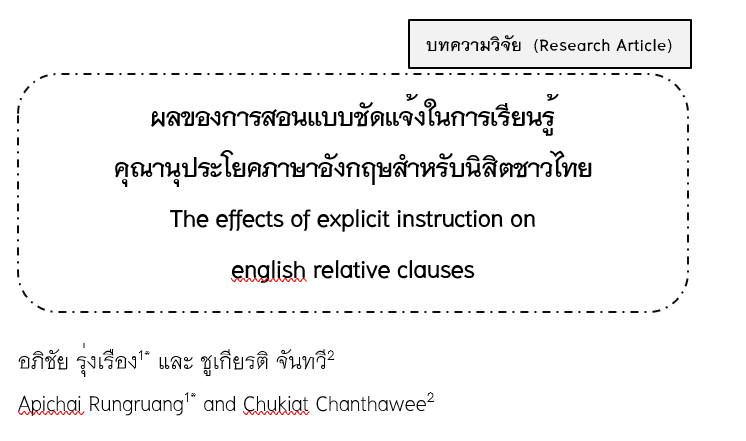The Effects of Explicit Instruction on English Relative Clauses
Keywords:
English Relative Clauses, The Noun Phrase Accessibility Hierarchy, Thai EFL LearnersAbstract
English relative clauses (ERCs) seem to be a problem for Thai EFL (English as a Foreign Language) learners. Literature always mentions ERCs as a part of syntactic problems. Thus, this study aims to solve this problem through a teaching model called explicit instruction. Another objective of the study is to what extent the university performance fits the Noun Phrase Accessibility Hierarchy (NPAH) in that Subject ERC is the easiest form and Genitive ERC is the more difficult one. Twenty-two English-major education students spent four weeks learning ERCs through the explicit instruction. The findings show that students performed better in a sentence combining test and a translation task; statistically significant difference was found in both tests. Nonetheless, their performance did not fit the NPAH in all cases. The Subject ERC became the easiest form to acquire, but the Object and Genitive ERCs show inconsistent results from the sentence combining test and the translation task. That is, students performed Genitive ERC better than the Object ERC, but in the translation task, student had higher score in Object ERC than Genitive ERC.
References
Alroudhan, E. H. (2016). The acquisition of English restrictive relative clauses by Arab Adult EFL Learners. Advances in Language and Literary Studies, 7(1), 33-53.
Amornwongpeeti, A., & Pongpairoj, N. (2014). The acquisition of English restrictive and non-restrictive relative clauses by L1 Thai Learners. NIDA Journal of Language and Communication, 19(21), 1-54.
Andrews, K. (2007) The effects of implicit and explicit instruction on simple and complex grammatical structures for adult English language learners. The Electronic Journal for English as a Second Language, 11(2), 1-5.
Archer, A. L., & Hughes, C. A. (2011). Explicit instruction: effective and efficient teaching. New York: The Guilford Press.
Caponigro, I., & Pear, L. (2009). The nominal nature of where, when, and how: Evidence from free relatives. Linguistic Inquiry, 40(1), 155–164.
Chaiyapho, P. (2017). The effect of explicit instruction by using phrase structure rules on acquisition of noun clauses. Master’s Thesis: Ubon Ratchathani University.
Choi, I. & Kim, J. (2008). Noun phrase accessibility and acquisition of English relative clauses by Korean learners. Linguistic Research, 25(2), 83-104.
Greenberg, J. H., ed.. (1963). Universals of Language. Massachusetts: MIT Press.
Gurevich, N. (2001). A critique of markedness-based theories in phonology. Studies in the Linguistic Sciences, 31(2), 89-114.
Intaraprapong, I. (2013). Comprehension of complex sentences by Thai students. (Master’s Thesis). Ubon Ratchathani: Ubon Ratchathani University.
Kanno, K (2007). Factors affecting the processing of Japanese relative clauses by L2 learners. Studies in Second Language Acquisition, 29(2), 197-218.
Keenan, E. L., & Comrie, B. (1979). Noun phrase accessibility hierarchy revisited. Language, 55(3), 649-664.
Keenan, E. L.,& Comrie, B. (1977). Noun phrase accessibility hierarchy and universal Grammar. Linguistic Inquiry, 8, 63-99.
Kuno, S. (1974). The position of relative clauses and conjunctions. Linguistic Inquiry, 1, 117-136.
Lee, C., & Lee, JS. (2012). Gap in “gapless” relative clauses in Korean and other Asian. UCLA Working Papers in Linguistics, Theories of Everything. 17, Article 25, 204-214.
Leenakitti, N., & Pongpairoj, N. (2019). A study of translation of relative clauses from English into Thai. PASAA: Journal of Language Teaching and Learning in Thailand, 58, 95-130.
Lin, C., & Chuang, S. (2014) Taiwanese EFL learners’ English relative clauses learning. International Journal of English Linguistics, 4(4), 99-106.
Madsen, R. (2016). Relative clauses in second language acquisition. Belgrade English Language and Literature Studies, 8, 91-105.
Nezakat-Alhossaini, M, Youhanaee, M, & Moinzadeh, A. (2014). Impact of explicit instruction on EFL learners’ implicit and explicit knowledge: A case of English relative clauses. Journal of Language and Linguistic Studies, 10(2), 183-199.
Ngamkitjawat, A. (2013). A comparative study of complex sentences in three English academic books. Rajabhat Chiangmai Research Journal, 14(2), 134-142.
Nuamthanom Kimura, L. (2015). Is Left or Right better? A branching direction and the processing of English relative clauses of Thai university students. Journal of Liberal Arts Ubon Ratchathani University, 11(1), 141-185.
Ozeki, H., & Shirai, Y. (2007). Does the Noun Phrase Accessibility Hierarchy predict the difficulty order in the acquisition of Japanese relative clauses?. Studies in Second Language Acquisition, 29(2), 169-196.
Phoocharoensil, S. (2009). A Study of English Relative Clauses in the Interlanguage of Thai EFL Learners. (Ph.D. dissertation). Bangkok: Chulalongkorn University.
Phoocharoensil, S. (2012). On the adverbial relativiser Where and prepositional relatives from an interlanguage perspective. Hong Kong Journal of Applied Linguistics, 13(2), 85-114.
Phoocharoensil, S. (2015). A corpus-based analysis of the relativizer THAT in L1-Thai speakers’ interlanguage. The International Journal of Communication and Linguistic Studies, 13(4), 49-66.
Phoocharoensil, S., & Simargool, N. (2010). English relativization and learners’ problems. Journal of Pan-Pacific Association of Applied Linguistics, 14(1), 109-129. Form http://files.eric.ed.gov/fulltext/EJ920506.pdf.
Promsupa, P; Varasarin, P& Brudhiprabha, P. (2017). An analysis of grammatical errors in English writing of Thai university students. HRD Journal, 8(1), 67-100.
Rattanasak, S., & Phoocharoensil, S. (2014). Avoidance in processing English non-restrictive relative clauses in Thai EFL learners’ interlanguage. Asian Social Science, 10(17), 265-277.
Renaud, C. (2011). The acquisition of French: the development of inflectional morphology and syntax in L1 acquisition, bilingualism, and L2 acquisition. Studies in Second Language Acquisition, 33(3), 464-466.
Şavran, E. (2022). Re-evaluation of Noun Phrase Accessibility Hierarchy (NPAH): Does It Work in Turkish EFL Context?. Education & Science. Turkish: EFE Academy, 159-173.
Thep-Ackrapong, T. (2009). Teaching English in Thailand: an uphill battle. Manutsat Paritat Journal of Humanities, 2(1), 51-62.
Waelateh, B; Boonsuk, Y; Ambele, E.A & Jaeharsae, F. (2019). An Analysis of the Written Errors of Thai EFL Students’ Essay Writing in English. Journal of Social Sciences and Humanities Research in Asia (JSHRA), 25(3), 55-82.
Wen, H. (2020). Relative Clauses in Mandarin Chinese. (Ph.D. dissertation). London: University of London.
Xu, Y. (2011). The accessibility hierarchy in Chinese relative clauses. Proceedings of the 16th Conference of Pan-Pacific Association of Applied Linguistics (68-73).
Yas, E. (2012). Acquisition of English relative clauses by German L1 and Turkish L1 speakers. (Ph.D. dissertation). Germany: Institut für Englische Philologie der Freien Universität Berlin.

Downloads
Published
How to Cite
Issue
Section
License
Copyright (c) 2023 Phayao University

This work is licensed under a Creative Commons Attribution-NonCommercial-NoDerivatives 4.0 International License.
ผู้นิพนธ์ต้องรับผิดชอบข้อความในบทนิพนธ์ของตน มหาวิทยาลัยพะเยาไม่จำเป็นต้องเห็นด้วยกับบทความที่ตีพิมพ์เสมอไป ผู้สนใจสามารถคัดลอก และนำไปใช้ได้ แต่จะต้องขออนุมัติเจ้าของ และได้รับการอนุมัติเป็นลายลักษณ์อักษรก่อน พร้อมกับมีการอ้างอิงและกล่าวคำขอบคุณให้ถูกต้องด้วย
The authors are themselves responsible for their contents. Signed articles may not always reflect the opinion of University of Phayao. The articles can be reproduced and reprinted, provided that permission is given by the authors and acknowledgement must be given.







